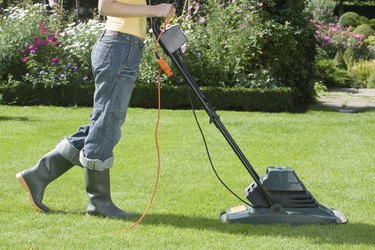
Electric lawn mowers and other electric gardening equipment are ecologically safe and easy for homeowners to use, but every year some 4,000 injuries occur from the misuse of extension cords that plug into these machines according to the Consumer Product Safety Commission. Knowing what kind of extension cord to use and using it safely will keep you from becoming an injury statistic yourself. Electric lawn mowers come in corded and cordless models, but you will need to buy extension cords separately.
Electric Advantages
Video of the Day
Electric lawn mowers are less expensive to maintain and they produce significantly less noise than do gas-powered mowers. Corded models require extension cords to plug into electrical outlets. The cord should match the power of the machine. The lawn mower's operator's manual lists specifications and recommendations for an extension cord suitable for individual model of lawn mower.
Video of the Day
Wattage and Length
Estimate the distance from the power outlet to the furthest area to be mowed. Heavy-duty, outdoor extension cords are available in 25- to 200-foot lengths. The amount of wattage a cord delivers is reduced by the length of the cord. A 16-gauge extension cord longer than 50 feet delivers 1,250 watts of power. The amount of wattage required for operation is indicated on the lawn mower or in the operator's manual.
Safety Standards
Safety standards for lawn mower extension cords are defined by the National Electrical Code and set by the National Consumer Products Safety Commission. Outdoor extension cords must be made with 16-gauge wire and equipped with a polarized plug. Polarized plugs have one blade wider than the other and can only be inserted one way into the outlet. The possibility of electrical shock is reduced by neutralizing one side of the circuit.
Extension Cord Care
Unroll a newly purchased extension cord in the sunlight for several hours to relax the rubber in the cable jacket. Suspend the cord gently above the floor or ground to stretch the jacket and conductors. This preparation makes subsequent coiling easier. Do not tie the extension cord in knots. Coil it with an underhand-overhand motion that does not resist the natural twisting tendency of the copper conductors. Always tie the coiled extension cord with a cable wrap or tie line and store in a dry place.